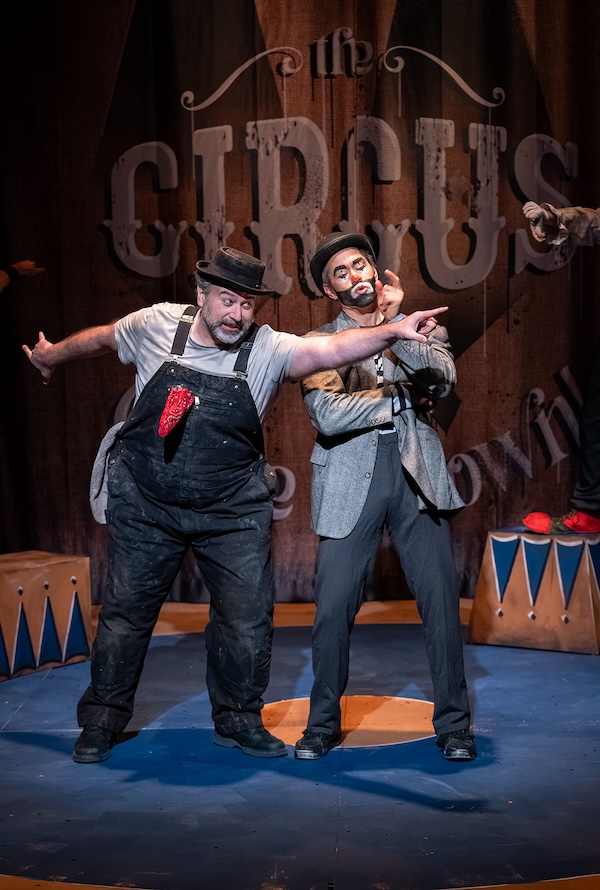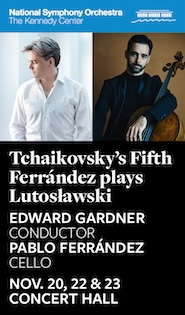IN Series’ scaled down “Rigoletto” brings big top lunacy to Verdi opera

Chad Louwerse (left) in the title role and Brian Arreola as the Duke in IN Series’ production of Verdi’s Rigoletto. Photo: Bayou Elom
When Timothy Nelson, then director of American Opera Theater, created a production of Handel’s Acis and Galatea in 2007 set in a circus, it made no sense and yet somehow worked.
Now director of IN Series, Nelson has brought the circus back to town for his staging of Verdi’s Rigoletto, in a new English translation by Bari Biern. The concept should work better in this opera, seeing how the title character is a jester. But as seen Saturday night in the Goldman Theater at Edlavitch JCC, Nelson did not play things the easy way.
Slimmed down to a cast of seven singers accompanied by seven instrumentalists, Nelson’s reworking casts Rigoletto as an overall-clad cleaning person for a traveling circus. Since all the other characters are turned into demented clowns, this inversion did increase sympathy for the cruel jester, sung with sensitivity and verve (and no hunchback or limp) by baritone Chad Louwerse. The moving Act II scenes of his distress at his daughter’s disappearance proved especially effective.
As Rigoletto’s daughter Gilda, Teresa Ferrara’s signature prop, a floating red balloon, accentuated her child-like nature as a woman sheltered by Rigoletto from the womanizing Duke of Mantua. The soprano struggled with this challenging role more than in some of her recent IN Series appearances, with fine staccato note placement but some wilting high notes at times, as in the Act I showcase of “Caro nome.” Her generally limpid tone and charming stage presence otherwise made her a splendid Gilda.
Tenor Brian Arreola sounded more solid as the Duke of Mantua, presented as a goofy mime (intentionally dingy costumes by Donna Breslin), than he has in other recent outings with IN Series. In both his big arias and the memorable Act III quartet, his high notes mostly soared and the weight of his voice carried easily in the small theater. Arreola doubled in the role of Gilda’s nurse, Giovanna, putting a mop head over his hair and braying a bit.
Andrew Adelsberger brought a potent bass-baritone resonance to the roles of the assassin Sparafucile and the wronged father Monterone, who places his curse on Rigoletto. He was costumed sometimes as the strong man, in a striped unitard, and sometimes as a hobo clown. Mezzo-soprano Elizabeth Mondragon, another IN Series favorite, spent most of the opera as a supernumerary–a mocking, almost satanic ringmaster–before taking the role of Maddalena in Act III.
Gregory Sliskovich and Henrique Carvalho, costumed as a red-wigged Bozo and a leering Pagliaccio, often stole the show as the villainous courtiers Borsa and Marullo. They also doubled in other minor roles, including the chorus of courtiers abducting Gilda and the moaning winds in the Act III storm scene. Sliskovich also hammed it up in the supernumerary role of a spiteful Harpo Marx-like character who honked a horn and walked a balloon dog on the end of a leash. The point of this addition became clear at the transition into Act III, a moment of black humor that should be left unspoiled.
Nelson pared down Verdi’s magnificent score to just seven instruments, including percussion. Violin, cello, and clarinet preserved essential solo moments, with the clarinet taking the second flute part in the important accompaniment to “Caro nome.” The trombone and clarinet added some grotesque funhouse glissandi at crucial moments, and the flutist squealed skillfully on piccolo to similar effect. The signature sound of Nelson’s re-orchestration was the electronic organ, played by music director Emily Baltzer, on a setting that evoked the hooty sound of a calliope.
Memorable parts of the opera could only be approximated, of course, including the offstage banda and onstage string ensemble in the opening party scene. The simple set design by Johnathan Dahm-Robertson centered on a backdrop, painted with the words “The circus is come to town,” often backlit for silhouette effects or harshly lit with wild bigtop spotlights (lighting by Paul Callahan).
On the other hand, Nelson’s direction produced new memorable moments. Arreola juggled adroitly while singing “La donna è mobile,” and at the end of “Caro nome,” Ferrara added a joke about inhaling helium from her balloon to hit her high notes. Even the “Entry of the Gladiators” by Julius Fučík, a chromatic tune now strongly associated with carnivals, got worked into the introduction to Act II. If nothing else, this often nutty adaptation should at least make you rethink how you understand one of Verdi’s greatest operas.
Rigoletto runs through December 15, including two performances at Baltimore Theatre Project. inseries.org





